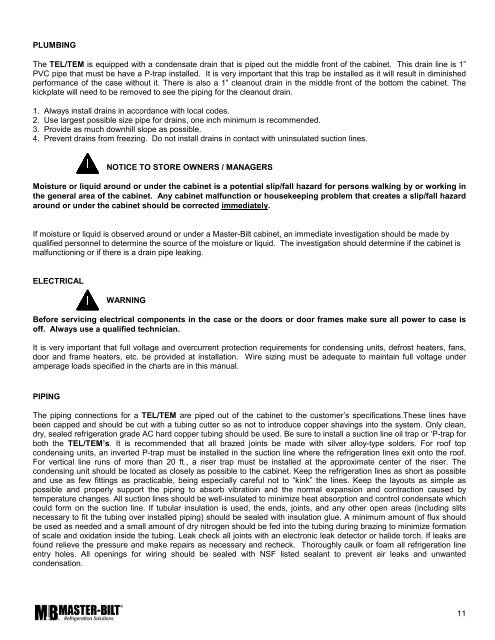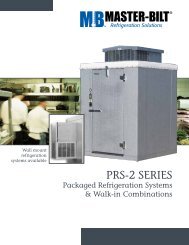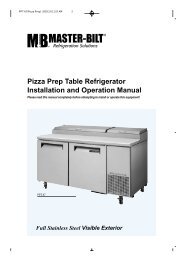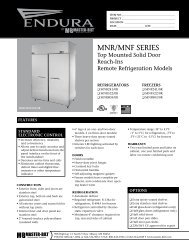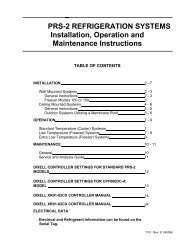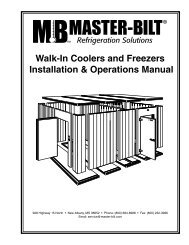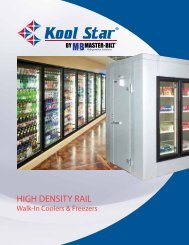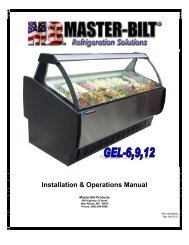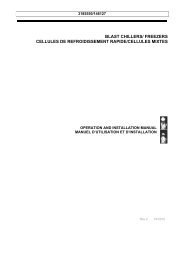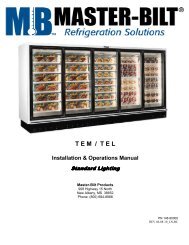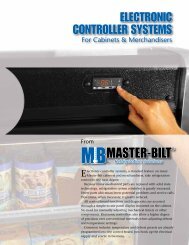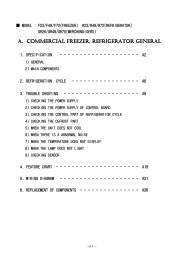TEL / TEM Installations & Operations Manual - Master-Bilt
TEL / TEM Installations & Operations Manual - Master-Bilt
TEL / TEM Installations & Operations Manual - Master-Bilt
You also want an ePaper? Increase the reach of your titles
YUMPU automatically turns print PDFs into web optimized ePapers that Google loves.
PLUMBING<br />
The <strong>TEL</strong>/<strong>TEM</strong> is equipped with a condensate drain that is piped out the middle front of the cabinet. This drain line is 1”<br />
PVC pipe that must be have a P-trap installed. It is very important that this trap be installed as it will result in diminished<br />
performance of the case without it. There is also a 1” cleanout drain in the middle front of the bottom the cabinet. The<br />
kickplate will need to be removed to see the piping for the cleanout drain.<br />
1. Always install drains in accordance with local codes.<br />
2. Use largest possible size pipe for drains, one inch minimum is recommended.<br />
3. Provide as much downhill slope as possible.<br />
4. Prevent drains from freezing. Do not install drains in contact with uninsulated suction lines.<br />
NOTICE TO STORE OWNERS / MANAGERS<br />
Moisture or liquid around or under the cabinet is a potential slip/fall hazard for persons walking by or working in<br />
the general area of the cabinet. Any cabinet malfunction or housekeeping problem that creates a slip/fall hazard<br />
around or under the cabinet should be corrected immediately.<br />
If moisture or liquid is observed around or under a <strong>Master</strong>-<strong>Bilt</strong> cabinet, an immediate investigation should be made by<br />
qualified personnel to determine the source of the moisture or liquid. The investigation should determine if the cabinet is<br />
malfunctioning or if there is a drain pipe leaking.<br />
ELECTRICAL<br />
WARNING<br />
Before servicing electrical components in the case or the doors or door frames make sure all power to case is<br />
off. Always use a qualified technician.<br />
It is very important that full voltage and overcurrent protection requirements for condensing units, defrost heaters, fans,<br />
door and frame heaters, etc. be provided at installation. Wire sizing must be adequate to maintain full voltage under<br />
amperage loads specified in the charts are in this manual.<br />
PIPING<br />
The piping connections for a <strong>TEL</strong>/<strong>TEM</strong> are piped out of the cabinet to the customer’s specifications.These lines have<br />
been capped and should be cut with a tubing cutter so as not to introduce copper shavings into the system. Only clean,<br />
dry, sealed refrigeration grade AC hard copper tubing should be used. Be sure to install a suction line oil trap or ‘P-trap for<br />
both the <strong>TEL</strong>/<strong>TEM</strong>’s. It is recommended that all brazed joints be made with silver alloy-type solders. For roof top<br />
condensing units, an inverted P-trap must be installed in the suction line where the refrigeration lines exit onto the roof.<br />
For vertical line runs of more than 20 ft., a riser trap must be installed at the approximate center of the riser. The<br />
condensing unit should be located as closely as possible to the cabinet. Keep the refrigeration lines as short as possible<br />
and use as few fittings as practicable, being especially careful not to “kink” the lines. Keep the layouts as simple as<br />
possible and properly support the piping to absorb vibratioin and the normal expansion and contraction caused by<br />
temperature changes. All suction lines should be well-insulated to minimize heat absorption and control condensate which<br />
could form on the suction line. If tubular insulation is used, the ends, joints, and any other open areas (including slits<br />
necessary to fit the tubing over installed piping) should be sealed with insulation glue. A minimum amount of flux should<br />
be used as needed and a small amount of dry nitrogen should be fed into the tubing during brazing to minimize formation<br />
of scale and oxidation inside the tubing. Leak check all joints with an electronic leak detector or halide torch. If leaks are<br />
found relieve the pressure and make repairs as necessary and recheck. Thoroughly caulk or foam all refrigeration line<br />
entry holes. All openings for wiring should be sealed with NSF listed sealant to prevent air leaks and unwanted<br />
condensation.<br />
11


